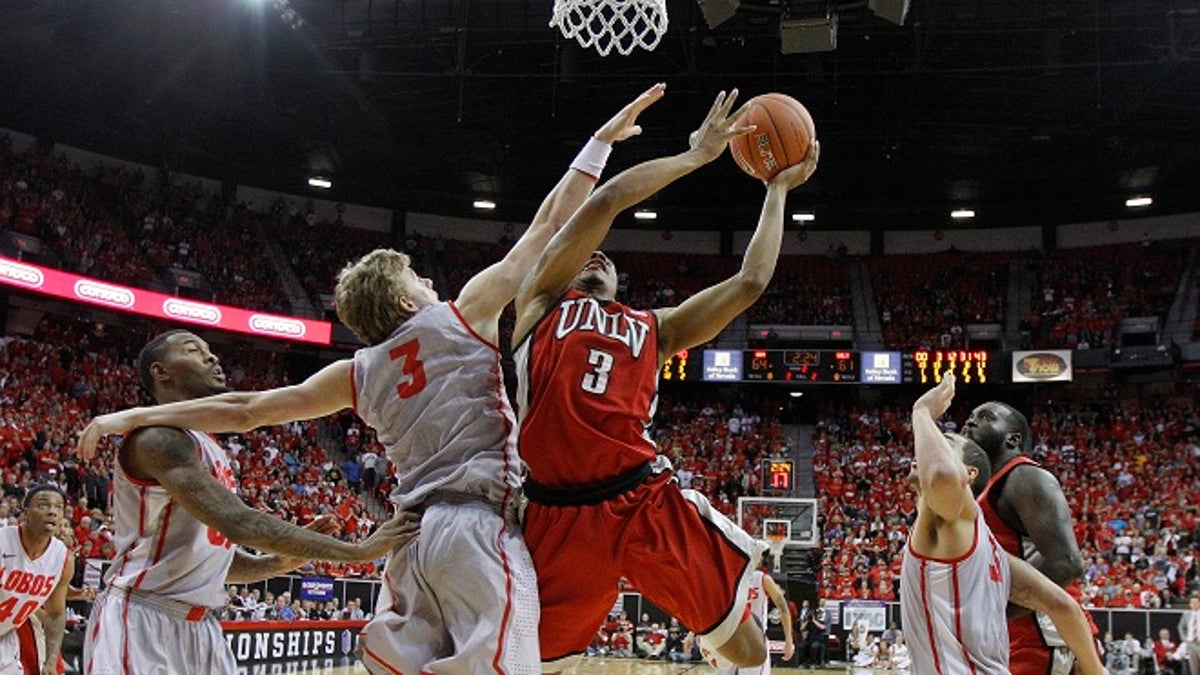
UNLV's Anthony Marshall is fouled by New Mexico's Hugh Greenwood in the second half of a semifinal NCAA college basketball game during the Mountain West Conference tournament, Friday, March 9, 2012, in Las Vegas. (AP Photo/Julie Jacobson) (AP2012)
Each March, the otherwise obscure field of "bracketology" becomes a premier discipline in the U.S.
As pundits and fans debate the 68 teams that most deserve to participate in the NCAA Division I Men's basketball tournament, researchers have proposed a new method for placing the chosen teams into brackets that could lead to million-dollar savings on travel costs and even increase attendance.
This weekend the official selection committee convenes to choose and seed the teams for this year's contest. The proposed alternative method would not change the seeds, but the way teams are assigned into the four regional brackets.
The researchers' technique might not make for more exciting games, but in 2011 it would have reduced the travel burden on schools by more than 28 percent.
Operations researchers Sharif Melouk and Burcu Keskin at the University of Alabama, in Tuscaloosa, developed a method to reduce travel distances when assigning teams to the initial tournament game locations. The method maintains the guidelines expressed by the NCAA, such as rewarding top teams with games relatively close to home and avoiding early-round battles between teams from the same conference.
Unlike most previous research on the topic, the method focuses on the first full weekend of the tournament and does not extend to the subsequent rounds due to the tournament's penchant for surprise upsets.
The selection committee chooses the 68 teams that make each year's tournament from two primary categories, including automatic bids, which are awarded to the winners of conference tournaments (and also to the Ivy League regular season champion), and at-large bids, which are decided by the selection committee. The committee separates teams into four brackets, each seeded from 1 to 16. The four best teams each receive number one seeds and are placed in different brackets. The next best four are given two seeds, and so on. Four games (the first round) are played on the Tuesday and Wednesday in order to trim the field to 64 teams before the traditional Thursday start of the tournament (now called the second round).
The Alabama researchers' model uses the selection committee's seeding and disperses the games over the eight locations where the second and third round games are played. They weigh the priority of the teams, giving the highest seeded teams the best chance to play close to home, and attempt to minimize the amount of miles traveled by the tournament teams.
"[The NCAA] could use these models very easily to optimally assign [the teams]," said Melouk. "This model that we created to do this runs literally in one second."
Barbara Fratacelli, an operations researcher at Virginia Polytechnic Institute and University in Blacksburg, and her colleagues previously developed a method for optimizing tournament scheduling, which considers additional factors to improve the mileage savings. This included looking at the likely outcome of early-round games and how that might affect travel distances for the later rounds. It also allows seeds to shift slightly for the sake of fitting the teams into the best brackets, mimicking something that the selection committee considers, she said.
The Alabama researchers' method offers the selection committee the chance to adjust to the results of games happening in the last few hours or days before the tournament brackets are finalized.
This effort isn't just about reducing the travel costs and burden upon teams and fans, it's about finding a way to keep teams closer to home, where their fans might be more likely to fill up the arenas, said Melouk. "We're keeping everybody closer to home where hopefully more and more people will have interest in the games and that way they'll go."
"Melouk [and Keskin] demonstrate that the NCAA could greatly benefit from using mathematical modeling," said Mike Fry, an operations researcher at the University of Cincinnati. He added that using the model could reduce the cost of transporting the basketball teams and support staff by more than $1 million.
The research was published last year in the Journal of the Operational Research Society.
